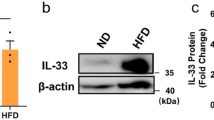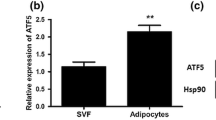Abstract
Background
FOXO3a is a widely studied transcription factor and plays an important role in a variety of biology. The purpose of this study was to explore the role and potential mechanism of FOXO3a on lipid accumulation and adipocyte inflammation in adipocytes through regulation of autophagy.
Methods
The obese mouse model was successfully induced by high-fat diet. SiRNA targeting FOXO3a was transfected into differentiation of 3T3-L1 adipocytes to reduce the expression of FOXO3a. The culture medium of RAW264.7 cells was added to the differentiated 3T3-L1 adipocytes to form a co-culture system. Subsequently, ELISA or AdipoRed assay was performed to measure the expression of triglyceride (TG) and cholesterol (TC) in mouse adipose tissue or differentiation of 3T3-L1 adipocytes. Adipocyte differentiation was detected by Oil Red O-staining. Ad-mCherry-GFP-LC3II was used to detect the level of autophagy in differentiation of 3T3-L1 adipocytes. Western blotting or qRT-PCR was used to detect the expression of FOXO3a, autophagy-related proteins (beclin 1, CEBPβ, PPARγ, ACC1 and KLF4), inflammatory cytokines (TNF-α, IL-1β, IL-6 and MCP1), NF-κB signal pathway-related proteins or adipokines (Adiponectin, AdipoR1 and resistin) in differentiated 3T3-L1 or RAW264.7 cells.
Results
The expression of FOXO3a and autophagy levels were significantly increased in visceral adipose tissue of obese mice and differentiation of 3T3-L1 adipocytes. Downregulation of FOXO3a significantly inhibited the autophagy and lipid accumulation in differentiation of 3T3-L1 adipocytes. In addition, FOXO3a knockdown significantly reduced Lipopolysaccharide (LPS)-induced inflammation and adipokines release in RAW264.7 cells treated with the culture medium of 3T3-L1 adipocytes. These above activity changes could be reversed by autophagy inducer rapamycin.
Conclusion
FOXO3a could promote lipid accumulation and inflammation in differentiated 3T3-L1 adipocytes by targeting autophagy. Our results provide a new theoretical basis for FOXO3a to regulate obesity.







Similar content being viewed by others
Availability of data and materials
The experimental data will be available on the request.
References
Flegal KM, Kruszon-Moran D, Carroll MD, Fryar CD, Ogden CL. Trends in obesity among adults in the United States, 2005 to 2014. JAMA. 2016;315:2284–91.
Ogden CL, Carroll MD, Lawman HG, Fryar CD, Kruszon-Moran D, Kit BK, et al. Trends in obesity prevalence among children and adolescents in the United States, 1988–1994 through 2013–2014. JAMA. 2016;315:2292–9.
Bettaieb A, Cremonini E, Kang H, Kang J, Haj FG, Oteiza PI. Anti-inflammatory actions of (–)-epicatechin in the adipose tissue of obese mice. Int J Biochem Cell Biol. 2016;81:383–92.
Vernooij JW, van der Graaf Y, Visseren FL, Spiering W. The prevalence of obesity-related hypertension and risk for new vascular events in patients with vascular diseases. Obesity (Silver Spring, Md). 2012;20:2118–23.
Zheng W, Xie W, Yin D, Luo R, Liu M, Guo F. ATG5 and ATG7 induced autophagy interplays with UPR via PERK signaling. Cell Commun Signal. 2019;17:42.
Echeverría F, Ortiz M, Valenzuela R, Videla LA. Long-chain polyunsaturated fatty acids regulation of PPARs, signaling: relationship to tissue development and aging. Prostaglandins Leukot Essent Fatty Acids. 2016;114:28–34.
Illesca P, Valenzuela R, Espinosa A, Echeverría F, Soto-Alarcon S, Ortiz M, et al. Hydroxytyrosol supplementation ameliorates the metabolic disturbances in white adipose tissue from mice fed a high-fat diet through recovery of transcription factors Nrf2, SREBP-1c, PPAR-γ and NF-κB. Biomed Pharmacother. 2019;109:2472–81.
Bai Y, Meng L, Han L, Jia Y, Zhao Y, Gao H, et al. Lipid storage and lipophagy regulates ferroptosis. Biochem Biophys Res Commun. 2019;508:997–1003.
Singh R, Xiang Y, Wang Y, Baikati K, Cuervo AM, Luu YK, et al. Autophagy regulates adipose mass and differentiation in mice. J Clin Invest. 2009;119:3329–39.
Bae J, Jang Y, Kim H, Mahato K, Schaecher C, Kim IM, et al. Arsenite exposure suppresses adipogenesis, mitochondrial biogenesis and thermogenesis via autophagy inhibition in brown adipose tissue. Sci Rep. 2019;9:14464.
Nakajima S, Nishimoto Y, Tateya S, Iwahashi Y, Okamatsu-Ogura Y, Saito M, et al. Fat-specific protein 27α inhibits autophagy-dependent lipid droplet breakdown in white adipocytes. J Diabetes Investig. 2019;10:1419–29.
Mirzaei H, Masoudifar A, Sahebkar A, Zare N, Sadri Nahand J, Rashidi B, et al. MicroRNA: a novel target of curcumin in cancer therapy. J Cell Physiol. 2018;233:3004–15.
Tran H, Brunet A, Grenier JM, Datta SR, Fornace AJ Jr, DiStefano PS, et al. DNA repair pathway stimulated by the forkhead transcription factor FOXO3a through the Gadd45 protein. Science. 2002;296:530–4.
Zhao J, Brault JJ, Schild A, Cao P, Sandri M, Schiaffino S, et al. FoxO3 coordinately activates protein degradation by the autophagic/lysosomal and proteasomal pathways in atrophying muscle cells. Cell Metab. 2007;6:472–83.
Mammucari C, Milan G, Romanello V, Masiero E, Rudolf R, Del Piccolo P, et al. FoxO3 controls autophagy in skeletal muscle in vivo. Cell Metab. 2007;6:458–71.
Im J, Hergert P, Nho RS. Reduced FoxO3a expression causes low autophagy in idiopathic pulmonary fibrosis fibroblasts on collagen matrices. Am J Physiol Lung Cell Mol Physiol. 2015;309:L552–61.
Li Y, Wang H, Pei F, Chen Z, Zhang L. FoxO3a Regulates Inflammation-induced Autophagy in Odontoblasts. J Endod. 2018;44:786–91.
Ju L, Han J, Zhang X, Deng Y, Yan H, Wang C, et al. Obesity-associated inflammation triggers an autophagy-lysosomal response in adipocytes and causes degradation of perilipin 1. Cell Death Dis. 2019;10:121.
Ko S, Gu MJ, Kim CG, Kye YC, Lim Y, Lee JE, et al. Rapamycin-induced autophagy restricts porcine epidemic diarrhea virus infectivity in porcine intestinal epithelial cells. Antiviral Res. 2017;146:86–95.
Bourlier V, Bouloumie A. Role of macrophage tissue infiltration in obesity and insulin resistance. Diabetes Metab. 2009;35:251–60.
Kim CY, Kang B, Suh HJ, Choi HS. Red ginseng-derived saponin fraction suppresses the obesity-induced inflammatory responses via Nrf2-HO-1 pathway in adipocyte-macrophage co-culture system. Biomed Pharmacother. 2018;108:1507–16.
Jou PC, Ho BY, Hsu YW, Pan TM. The effect of Monascus secondary polyketide metabolites, monascin and ankaflavin, on adipogenesis and lipolysis activity in 3T3-L1. J Agric Food Chem. 2010;58:12703–9.
Fève B. Adipogenesis: cellular and molecular aspects. Best Pract Res Clin Endocrinol Metab. 2005;19:483–99.
Guru A, Issac PK, Velayutham M, Saraswathi NT, Arshad A, Arockiaraj J. Molecular mechanism of down-regulating adipogenic transcription factors in 3T3-L1 adipocyte cells by bioactive anti-adipogenic compounds. Mol Biol Rep. 2021;48:743–61.
Blüher M. The distinction of metabolically “healthy” from “unhealthy” obese individuals. Curr Opin Lipidol. 2010;21:38–43.
Li L, Zviti R, Ha C, Wang ZV, Hill JA, Lin F. Forkhead box O3 (FoxO3) regulates kidney tubular autophagy following urinary tract obstruction. J Biol Chem. 2017;292:13774–83.
Shin HR, Kim H, Kim KI, Baek SH. Epigenetic and transcriptional regulation of autophagy. Autophagy. 2016;12:2248–9.
Chi Y, Shi C, Zhao Y, Guo C. Forkhead box O (FOXO) 3 modulates hypoxia-induced autophagy through AMPK signalling pathway in cardiomyocytes. Biosci Rep. 2016;36:e00345.
Li C, Wang Z, Wang C, Ma Q, Zhao Y. Perivascular adipose tissue-derived adiponectin inhibits collar-induced carotid atherosclerosis by promoting macrophage autophagy. PLoS ONE. 2015;10:e0124031.
Luo L, Lu AM, Wang Y, Hong A, Chen Y, Hu J, et al. Chronic resistance training activates autophagy and reduces apoptosis of muscle cells by modulating IGF-1 and its receptors, Akt/mTOR and Akt/FOXO3a signaling in aged rats. Exp Gerontol. 2013;48:427–36.
Tsai YC, Leu SY, Chen SY, Kung CW, Lee YM, Liu YP, et al. 17-DMAG, an Hsp90 inhibitor, ameliorates ovariectomy-induced obesity in rats. Life Sci. 2019;232:116672.
Nishimura S, Manabe I, Nagasaki M, Seo K, Yamashita H, Hosoya Y, et al. In vivo imaging in mice reveals local cell dynamics and inflammation in obese adipose tissue. J Clin Invest. 2008;118:710–21.
Nakahira K, Haspel JA, Rathinam VA, Lee SJ, Dolinay T, Lam HC, et al. Autophagy proteins regulate innate immune responses by inhibiting the release of mitochondrial DNA mediated by the NALP3 inflammasome. Nat Immunol. 2011;12:222–30.
Yoshizaki T, Kusunoki C, Kondo M, Yasuda M, Kume S, Morino K, et al. Autophagy regulates inflammation in adipocytes. Biochem Biophys Res Commun. 2012;417:352–7.
Kosacka J, Kern M, Klöting N, Paeschke S, Rudich A, Haim Y, et al. Autophagy in adipose tissue of patients with obesity and type 2 diabetes. Mol Cell Endocrinol. 2015;409:21–32.
Cao Y, Chen J, Ren G, Zhang Y, Tan X, Yang L. Punicalagin prevents inflammation in LPS-induced RAW264.7 macrophages by inhibiting FoxO3a/autophagy signaling pathway. Nutrients. 2019;11:2794.
Illesca P, Valenzuela R, Espinosa A, Echeverría F, Soto-Alarcón S, Ortiz M, et al. The metabolic dysfunction of white adipose tissue induced in mice by a high-fat diet is abrogated by co-administration of docosahexaenoic acid and hydroxytyrosol. Food Funct. 2020;11:9086–102.
Funding
Natural Science Foundation of Shanghai (18ZR1435800).
Author information
Authors and Affiliations
Contributions
Xiaoyan Zhang: project development, data analysis and collection, manuscript writing. QL: project development, data analysis and collection, manuscript writing. Xuane Zhang: project development, data collection. KG: project development, data collection. Xuelian Zhang: project development, manuscript editing. ZZ: project development, manuscript editing.
Corresponding author
Ethics declarations
Conflict of interest
The authors declare they have no competing interests.
Ethics approval and consent to participate
All the above experimental operations have been approved by the ethics committee of the Yangpu Hospital, Tongji University School of Medicine.
Consent for publication
All authors have read the manuscript and agreed to submit it.
Additional information
Responsible Editor: John Di Battista.
Publisher's Note
Springer Nature remains neutral with regard to jurisdictional claims in published maps and institutional affiliations.
Rights and permissions
About this article
Cite this article
Zhang, X., Liu, Q., Zhang, X. et al. FOXO3a regulates lipid accumulation and adipocyte inflammation in adipocytes through autophagy. Inflamm. Res. 70, 591–603 (2021). https://doi.org/10.1007/s00011-021-01463-0
Received:
Revised:
Accepted:
Published:
Issue Date:
DOI: https://doi.org/10.1007/s00011-021-01463-0




